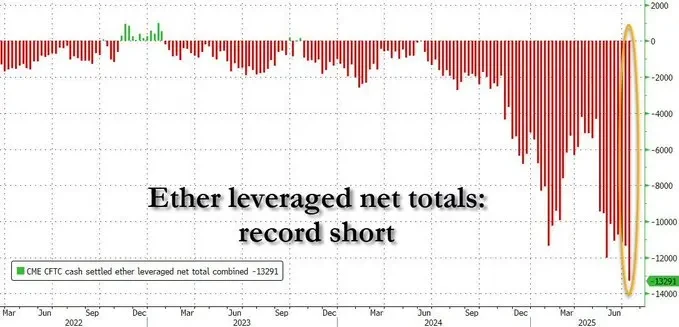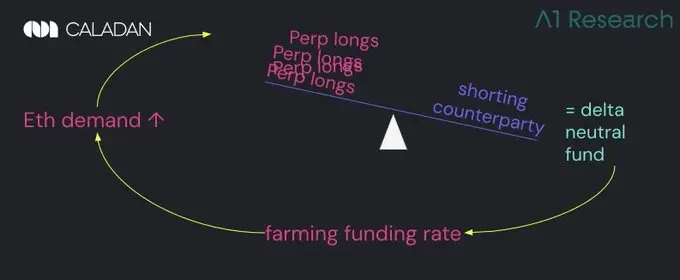Original Author: A1Research
Original Translation: Tim, PANews
The price fluctuations of Ethereum seem straightforward: retail enthusiasm surges, prices skyrocket, and market optimism continues to ferment. However, beneath the surface lies a structurally complex market mechanism. The intertwining of funding rate markets, hedging operations by neutral strategy institutions, and recursive leverage demand exposes deep systemic vulnerabilities in the current crypto market.
We are witnessing a rare phenomenon: leverage has essentially become liquidity itself. The massive long positions taken by retail investors are fundamentally reshaping the way neutral capital allocation risks are managed, thereby giving rise to a new type of market vulnerability that most market participants have yet to fully recognize.
Retail Herding Behavior: When Market Actions Become Highly Correlated
Retail demand is concentrated in Ethereum perpetual contracts, as these leveraged products are easily accessible. Traders are flooding into leveraged long positions at a pace far exceeding the actual demand for spot trading. The number of people betting on ETH's rise far surpasses those actually purchasing Ethereum in the spot market.
These positions require counterparties to take on the risk. However, as buying demand becomes exceptionally aggressive, short positions are increasingly absorbed by institutional players executing Delta neutral strategies. These are not directional bears; rather, they are funding rate harvesters who engage not to short ETH but to exploit structural imbalances for arbitrage.
In reality, this practice is not traditional shorting. These traders short perpetual contracts while holding equivalent amounts of spot or futures long positions. As a result, they do not bear ETH price risk, but they profit from the funding rate premium paid by retail longs to maintain their leveraged positions.
With the evolution of the Ethereum ETF structure, this arbitrage trading may soon be enhanced by the addition of passive income layers (staking returns embedded in the ETF packaging structure), further strengthening the appeal of Delta neutral strategies.
This is indeed a brilliant trade, provided you can tolerate its complexity.

Delta Neutral Hedging Strategy: A Legitimate "Money Printing" Response Mechanism
Traders short ETH perpetual contracts to accommodate retail long demand while hedging with spot long positions, thus converting the structural imbalance caused by persistent funding rate demand into profit.
In a bull market, funding rates turn positive, requiring longs to pay fees to shorts. Institutions employing neutral strategies hedge risks while earning profits by providing liquidity, creating profitable arbitrage operations that attract continuous inflows of institutional capital.
However, this gives rise to a dangerous illusion: the market appears deep enough and stable, but this "liquidity" depends on a favorable funding environment.
The moment the incentive mechanism disappears, the structure it supports will collapse. The apparent market depth will instantly vanish, and as the market framework crumbles, prices may experience violent fluctuations.
This dynamic is not limited to crypto-native platforms. Even at the institution-dominated Chicago Mercantile Exchange, most short liquidity is not directional bets. Professional traders short CME futures because their investment strategies prohibit opening spot exposures.
Options market makers use futures for Delta hedging to improve margin efficiency. Institutions are responsible for hedging institutional client order flows. These are all structural necessary trades, not reflections of bearish expectations. Open interest may rise, but this rarely conveys market consensus.
Asymmetric Risk Structure: Why It Is Not Fair
Retail longs face direct liquidation risks when prices move unfavorably, while Delta neutral shorts typically have more substantial capital and are managed by professional teams.
They collateralize their held ETH as collateral, allowing them to short perpetual contracts under a fully hedged, capital-efficient mechanism. This structure can safely withstand moderate leverage without triggering liquidation.
There are structural differences between the two. Institutional shorts possess enduring resilience and a comprehensive risk management system to withstand volatility; meanwhile, leveraged retail longs have weak capacity and lack risk control tools, with almost zero tolerance for error in their operations.
When market conditions shift, longs will quickly collapse, while shorts remain solid. This imbalance can trigger a seemingly sudden but structurally inevitable liquidation cascade.
Recursive Feedback Loop: When Market Behavior Becomes Self-Interfering

The demand for Ethereum perpetual contracts continues to exist, requiring Delta neutral strategy traders to act as counterparties for short hedging, which keeps the funding rate premium persistent. Various protocols and yield products compete to chase these premiums, driving more capital back into this cyclical system.
A never-ending money-making machine does not exist in reality.
This will continue to create upward pressure, but it entirely depends on one prerequisite: longs must be willing to bear the cost of leverage.
The funding rate mechanism has an upper limit. At most exchanges (like Binance), the funding rate cap for perpetual contracts is 0.01% every 8 hours, equating to an annualized yield of about 10.5%. When this cap is reached, even if long demand continues to grow, profit-seeking shorts will no longer be incentivized to open positions.
Risk accumulation reaches a critical point: arbitrage profits are fixed, but structural risks continue to grow. When this critical point arrives, the market is likely to experience rapid liquidations.
Why Does ETH Drop More Severely Than BTC? The Dual-Ecosystem Narrative Struggle
Bitcoin benefits from non-leveraged buying driven by corporate financial strategies, while the BTC derivatives market has stronger liquidity. Ethereum perpetual contracts are deeply integrated into yield strategies and DeFi protocol ecosystems, with ETH collateral continuously flowing into structured products like Ethena and Pendle, providing yield returns for users participating in funding rate arbitrage.
Bitcoin is often seen as driven by natural spot demand from ETFs and corporations. However, a significant portion of ETF capital flows is actually the result of mechanical hedging: traditional financial basis traders buy ETF shares while shorting CME futures contracts to lock in fixed price differentials between spot and futures for arbitrage.
This is fundamentally the same as ETH's Delta neutral basis trading, only executed through regulated packaging structures and financed at a 4-5% dollar cost. Viewed this way, ETH's leveraged operations become yield infrastructure, while BTC's leverage forms structured arbitrage. Neither is directional trading; both aim to obtain yields.
Cyclical Dependency Issue: When the Music Stops
Here’s a question that might keep you up at night: this dynamic mechanism has an inherent cyclical nature. The profitability of Delta neutral strategies relies on a continuously positive funding rate, which requires sustained retail demand and a bull market environment.
Funding rate premiums do not exist permanently; they are very fragile. When premiums contract, liquidation waves will begin. If retail enthusiasm wanes, funding rates will turn negative, meaning that shorts will pay fees to longs instead of collecting premiums.
When large-scale capital flows in, this dynamic mechanism creates multiple vulnerabilities. First, as more capital flows into Delta neutral strategies, the basis will continue to compress. Financing rates will decline, and the profits from arbitrage trading will also decrease.
If demand reverses or liquidity dries up, perpetual contracts may enter a discount state, meaning contract prices fall below spot prices. This phenomenon will hinder new Delta neutral positions from entering and may force existing institutions to liquidate. Meanwhile, leveraged longs lack margin buffer space, and even a mild market correction could trigger a chain liquidation.
When neutral traders withdraw liquidity and longs are forcibly liquidated in a waterfall manner, a liquidity vacuum forms, leaving no real directional buyers below the price, only structural sellers. The originally stable arbitrage ecosystem quickly flips, evolving into a chaotic liquidation wave.
Misreading Market Signals: The Illusion of Balance
Market participants often misinterpret the flow of hedging funds as bearish sentiment. In reality, high short positions in ETH often reflect profitable basis trading rather than directional expectations.
In many cases, the seemingly robust depth of the derivatives market is actually supported by temporary liquidity provided by neutral trading desks, which harvest funding premiums for profit.
While the inflow of funds into spot ETFs can generate a certain degree of natural demand, the vast majority of trading in the perpetual contract market essentially belongs to structural artificial operations.
The liquidity of Ethereum is not rooted in belief in its future; it exists as long as the funding environment is profitable. Once profits dissipate, liquidity will also vanish.
Conclusion
The market can remain active for a long time under structural liquidity support, creating a false sense of security. However, when conditions reverse and longs cannot maintain their financing obligations, a collapse can happen in an instant. One side is completely crushed, while the other withdraws calmly.
For market participants, recognizing these patterns signifies both opportunity and risk. Institutions can profit by understanding funding conditions, while retail investors should discern between artificial depth and real depth.
The driving forces behind the Ethereum derivatives market are not consensus on decentralized computing but rather the structural harvesting of funding rate premiums. As long as funding rates remain positively yielding, the entire system can operate smoothly. However, when conditions reverse, people will ultimately discover that the seemingly balanced facade is merely a carefully disguised leverage game.
免责声明:本文章仅代表作者个人观点,不代表本平台的立场和观点。本文章仅供信息分享,不构成对任何人的任何投资建议。用户与作者之间的任何争议,与本平台无关。如网页中刊载的文章或图片涉及侵权,请提供相关的权利证明和身份证明发送邮件到support@aicoin.com,本平台相关工作人员将会进行核查。


